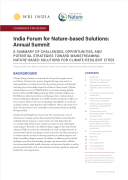India Forum for Nature-based Solutions: Annual Summit
by , , and -The proceedings summarize discussions from the first annual summit by the India Forum for Nature-based Solutions co-hosted on 6th August 2024 by the Council on Energy, Environment and Water (CEEW), India Climate Collaborative (ICC), National Institute of Urban Affairs (NIUA) Climate Centre for Cities (C-Cube), The Nature Conservancy (TNC), Wetlands International South Asia (WISA), WWF India, and WRI India.
The event brought together public and private actors across the ecosystem, with the intention to build synergies, foster dialogue, share learnings, and increase awareness about how NbS can be used to build resilient Indian cities. Discussions focused on strengthening mechanisms for the adoption of NbS, with an agenda framed around the value chain for delivering NbS.
Sessions at the summit included plenary discussions on the Indian urban context; the climate risks and vulnerabilities of Indian cities; and mechanisms and best practices for selecting, implementing, financing, and evaluating the outcomes of NbS projects.


